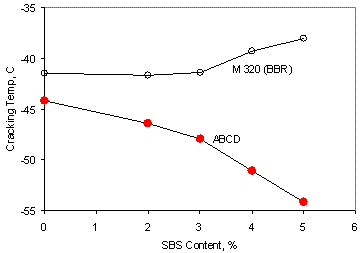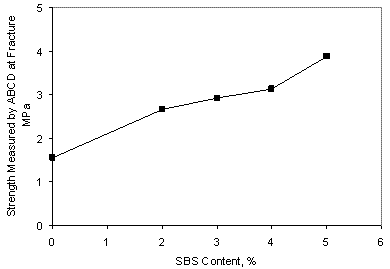Asphalt Binder Cracking Device to Reduce Low-Temperature Asphalt Pavement Cracking
SIGNIFICANCE OF THE ASPHALT BINDER CRACKING DEVICE
Low-temperature cracking is one of the major failure modes in asphalt pavements and is largely influenced by asphalt binder properties. The Asphalt Binder Cracking Device (ABCD) is a new test method determining the low-temperature cracking potential of asphalt binder in a field-like condition without prior knowledge of rheological properties, tensile strength, and coefficient of thermal expansion/contraction (CTE) of the binder.(1,2,3) For the ABCD test, a circular asphalt binder specimen is prepared on the outside of an Invar ring 50.8 mm (2.00 in.) in diameter. Invar is a steel alloy with near-zero CTE. As the temperature is lowered, the thermal stress within the asphalt specimen increases until fracture. The data from the instrumented sensors are used to determine the temperature and strength at the moment of fracture.
The current Performance-Graded (PG) binder grading system for low temperature is based on mechanistic-empirical analysis of thermal cracking. However, some of the important binder properties needed in the analysis, such as CTE and tensile strength, are not readily available due to the lack of adequate test equipment and method.(4) ABCD is a simple and easy-to-use testing device that can provide the overall low-temperature cracking potential of an asphalt binder. ABCD can be used by itself or in conjunction with other test methods to accurately grade asphalt binders for low-temperature performance. Findings from previous ABCD studies are summarized below.
The ABCD cracking temperatures were highly correlated with the performance of test pavements.(1) For field validation, ABCD tests were performed on asphalt binders used in three well-known test pavements: Elk County, Pennsylvania, Test Road; Lamont, Alberta, Test Road; and SPS-9A sections on Highway 17, Ontario. In all cases, the ABCD cracking temperatures correlated consistently better with crack severities of test pavements than AASHTO M 320 critical temperatures, as shown in table 1.
| Test Road | ABCD Cracking Temperature |
AASHTO Critical Temperature | |
|---|---|---|---|
| M 320 Table 1 (BBR) | M 320 Table 2 (BBR+DT) | ||
| Elk County, PA | 0.94 | 0.21 | 0.95 |
| Lamont, AB | 0.92 | 0.79 | 0.76 |
| Highway 17, ON | 0.80 | 0.92 | 0.56 |
BBR = Bending Beam Rheometer; DT = Direct Tension
The ABCD could measure polymer-modification effects on low-temperature thermal cracking. It is well known that the polymer-modified asphalts (PMAs) perform better for low-temperature cracking than unmodified asphalts. However, when PMAs are tested with the Bending Beam Rheometer (BBR), the effects of the polymer modification on the low-temperature performance of binders cannot be accurately determined. In a laboratory study, styrene-butadiene-styrene (SBS) polymer was added at varying concentrations and tested with both the BBR and the ABCD.(1) While BBR results (AASHTO M 320 Table 1) indicated that the polymer addition did not improve the low-temperature grade of the binder, ABCD results showed a clear and gradual decrease in the ABCD cracking temperature as the polymer concentration increased, as shown in figure 1.

Figure 1. Effect of SBS concentration on continuous PG low-temperature grade (AASHTO M 320 Table 1) and ABCD cracking temperature.
ABCD can measure the fracture strength of asphalt binders at the cracking temperature. The strain jump measured in the ABCD test is defined as the difference between compressive strains of the ABCD ring before and after thermal cracking. Using force equilibrium, the fracture strength at the ABCD cracking temperature can be estimated from the strain jump. As shown in figure 2, ABCD was able to measure the gradual increase of fracture strength with the increase of SBS concentration in asphalt binder.
The ruggedness study of the ABCD test procedure completed during Phase 1 showed that the ABCD test was robust against reasonable variation of cooling rate, specimen dimensions, and other test variables.(5) ABCD test results were not significantly affected by the expected variation of these test conditions.

Figure 2. Effect of SBS concentration on binder fracture strength measured by the ABCD.

